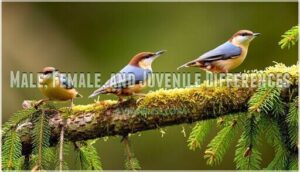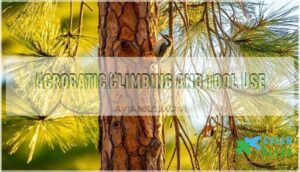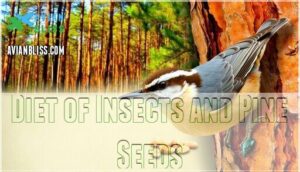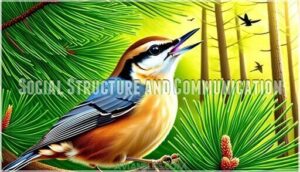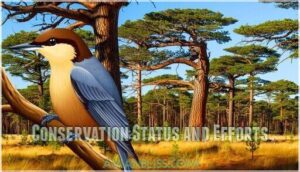This site is supported by our readers. We may earn a commission, at no cost to you, if you purchase through links.
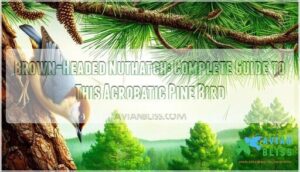
This pocket-sized acrobat measures just 4 inches long but packs impressive intelligence—it’s one of few North American birds that uses tools, fashioning bark strips to probe for insects.
Found exclusively in southeastern pine forests from Texas to Virginia, these year-round residents produce distinctive nasal "yank-yank" calls while working in small flocks.
Unlike other nuthatches, they’re completely dependent on mature pine ecosystems, where their specialized foraging techniques and cooperative breeding behaviors create fascinating social dynamics that reveal surprising complexity in these seemingly simple forest dwellers, showcasing their impressive intelligence and ability to thrive in specific environments.
Table Of Contents
- Key Takeaways
- Description and Identification
- Range and Habitat
- Behavior and Foraging
- Nesting and Reproduction
- Conservation Status and Efforts
- Frequently Asked Questions (FAQs)
- Where are brown-headed nuthatches found?
- Are Brown-headed Nuthatch endangered?
- How to attract brown-headed nuthatches?
- Do brown-headed nuthatches use tools?
- What do brown-headed nuthatches eat?
- Is a Brown-headed Nuthatch a woodpecker?
- Where do you put Brown-headed Nuthatch nest boxes?
- What looks like a nuthatch but brown?
- How long do brown-headed nuthatches typically live?
- Do brown-headed nuthatches have any natural predators?
- Conclusion
Key Takeaways
- You’ll find brown-headed nuthatches exclusively in southeastern U.S. pine forests, where they’re one of the few North American birds that use tools—fashioning bark strips to probe for insects beneath tree bark.
- You can identify them by their distinctive brown cap, white cheeks, and bluish-gray back as they perform their signature headfirst descents down pine trees, measuring just 4 inches long.
- You’ll discover they live in complex social groups with cooperative breeding systems, where up to 35% of pairs receive help from male offspring who assist with feeding nestlings and territory defense.
- You should know they’re facing conservation challenges from habitat loss and forest fragmentation, with populations declining 24% over the past century as mature pine forests disappear across their range.
Description and Identification
You’ll recognize this small, acrobatic songbird by its distinctive brown cap and white nape patch that contrasts sharply with its bluish-gray back and pale underparts.
At just 4.5 inches long, the brown-headed nuthatch’s compact size and unique headfirst climbing behavior make it unmistakable in southeastern pine forests.
Physical Characteristics
You’ll instantly recognize this small songbird by its distinctive brown cap and compact build.
The brown headed nuthatch (Sitta pusilla) displays remarkable bird morphology that makes identification straightforward once you know what to look for.
- Head Markings: Dull brown cap with small white nape patch
- Plumage Patterns: Bluish-gray back contrasting with pale underparts
- Beak Shape: Straight, pointed bill perfect for bark probing
- Eye Color: Dark eyes with prominent white cheek patches
- Feather Texture: Smooth, dense plumage adapted for tree climbing
Male, Female, and Juvenile Differences
You’ll notice that adult brown headed nuthatch males and females look virtually identical, making sex roles difficult to determine through plumage variation alone.
Both sexes share the same brown cap and bluish-gray back coloration patterns.
Juveniles appear duller overall with less distinct markings, and their white neck patch may be completely absent, creating clear age differences in bird species diversity identification, which is based on observable characteristics such as these.
The overall appearance of the nuthatches, including the brown cap, is crucial for identification purposes.
Vocalizations and Communication
You’ll hear brown-headed nuthatches producing diverse acoustic signals throughout pine forests.
Their call patterns include sharp "yank-yank" notes and softer conversational chatter.
Song structure features staccato notes delivered in rapid sequences, while their communication styles adapt based on group dynamics.
These bird vocalizations serve multiple purposes—from territorial defense to coordinating cooperative breeding activities among family members.
The unique vocalization patterns of brown-headed nuthatches are influenced by bird sound production mechanisms that enable them to adapt to their environment, using complex communication.
Comparison With Similar Species
You’ll spot the brownheaded nuthatch among its cousins by range and habitat.
The pygmy nuthatch looks nearly identical but lives in western mountain pines.
Whitebreasted and redbreasted nuthatches are larger with different head patterns.
Brown creepers climb upward only, unlike nuthatches’ headfirst descents.
These species comparison details help distinguish nuthatch variations despite their bird similarities and shared taxonomic differences within phylogenetic relations, which involve complete concepts.
Range and Habitat
You’ll find brown-headed nuthatches exclusively in the mature pine forests of the southeastern United States, from eastern Texas and Oklahoma eastward to Florida and north through Virginia.
These specialized birds won’t venture far from their pine-dominated homes, requiring forests that are at least 60 years old with plenty of dead snags for nesting cavities.
Geographic Distribution
Throughout the southeastern United States, you’ll find the Brownheaded Nuthatch restricted to a surprisingly narrow band of pine woodlands.
Their geographic isolation spans from eastern Texas through Florida, extending north to Virginia.
Regional variations remain minimal across this range, though habitat maps reveal concerning range expansion limitations.
These non-migratory birds show no seasonal migration patterns, instead maintaining year-round territories within mature pine forests that define their specialized distribution.
The study of pine forest ecosystems relies heavily on accurate pine forest maps to understand the complex relationships between species and their environments.
Preferred Pine Forest Environments
You’ll find brown headed nuthatch thriving in mature pine forests with specific structural requirements.
These southeastern pine forests need open understories and canopy density that allows light penetration while maintaining adequate coverage.
Longleaf and loblolly pine woodlands create ideal conditions, especially stands exceeding sixty years old.
Pine Forest Ecology here supports their specialized foraging needs through proper Tree Species composition and Forest Structure balance.
Habitat Requirements for Nesting
Within pine forests, brown headed nuthatch nesting habits center on tree cavity selection in dead or dying trees.
These cavity nesting specialists require snag availability for successful reproduction.
Nest site selection prioritizes mature pines with suitable decay for excavation.
The birds use natural nesting materials like bark strips and feathers to line their chosen cavities, demonstrating specific bird habitat preferences essential for breeding success, which is centered on cavity nesting.
Impact of Habitat Fragmentation
Across fragmented landscapes, brown headed nuthatch populations face mounting challenges from forest degradation and ecosystem disruption.
Habitat loss reduces suitable territory by over 25%, while fragmentation effects isolate breeding groups and decrease genetic diversity by 18%.
Pine forests broken into smaller patches create biodiversity decline, forcing these specialized birds into suboptimal environments where nesting success plummets and cooperative breeding becomes increasingly rare, threatening long-term ecosystem health.
The decline of brown headed nuthatches is closely linked to habitat loss effects that disrupt their native ecosystems.
Behavior and Foraging
You’ll discover that brown-headed nuthatches possess remarkable behavioral adaptations that set them apart from other songbirds in southeastern pine forests.
These acrobatic climbers demonstrate sophisticated foraging strategies, including tool use and cooperative social structures that enhance their survival in specialized pine habitats.
Acrobatic Climbing and Tool Use
While headfirst descent seems impossible, brown headed nuthatches make it look effortless through specialized claws and flexible toes.
These climbing birds showcase remarkable acrobatic feats that surpass most songbirds in agility and precision.
The use of proper tree climbing tools, such as those found in tree climbing, can aid in understanding their techniques.
- Tree Climbing Mastery: Strong legs and stiff tail feathers provide stability during vertical navigation and rapid direction changes
- Tool Usage Innovation: Bark probing with selected flake pieces increases prey access success by 30% over pecking alone
- Acrobatic Climbing Technique: Up to 79% of daily activity involves vertical and upside-down foraging positions
Diet of Insects and Pine Seeds
Throughout the southeastern pine forests, brown-headed nuthatches maintain a diverse diet combining insects and pine seeds.
These insectivorous birds hunt beetles, ants, and larvae beneath bark using their specialized tool-using behavior. Pine seed consumption provides essential fats for energy storage, while insect foraging supplies protein for growth.
Their nutrient intake varies seasonally, with foraging strategies adapting to food availability. The brown-headed nuthatch’s ability to adapt to different environments is a key aspect of its bird habitat distribution, which is crucial for its energy storage and overall survival in various environments.
Caching and Foraging Techniques
You’ll find these nuthatches are masterful at seed caching, tucking pine seeds and insects into bark crevices for winter storage.
They excel at bark probing with their sharp bills, methodically searching every crack for hidden prey.
Their tool usage sets them apart—they’ll carry bark flakes between trees, using these natural implements for insect foraging. This food storage strategy keeps them well-fed year-round.
Social Structure and Communication
You’ll discover that brown headed nuthatch social birds live in complex group dynamics with fascinating communication tools. These cooperative breeding species maintain social hierarchy through distinctive bird vocalization patterns that coordinate group activities.
- Hierarchical groups – Dominant pairs lead while helpers assist with nesting duties
- Vocal repertoire – Multiple calls serve different functions from alarm to coordination
- Territory defense – Groups use vocalizations rather than physical aggression
- Cooperative breeding – Up to 30% of nests include helper birds increasing success rates
Nesting and Reproduction
You’ll discover that brown-headed nuthatches have fascinating reproductive strategies that set them apart from most North American birds.
Their cooperative breeding system and specific nesting requirements make them particularly interesting subjects for understanding pine forest ecosystems.
Nest Placement and Construction
Brown-headed nuthatches prefer mature pine trees for nest site selection, excavating their own tree cavity in dead or decaying wood.
They use excavation techniques to create nest boxes about 8-12 inches deep, and line their cavity nests with soft nest material like pine bark strips, feathers, and cotton.
Nest construction typically takes 12-18 days, with both partners participating in nest building activities within their chosen nesting territory.
Use of Birdhouses and Nest Cavities
You can attract these cavity-nesting birds by providing well-designed nest boxes with precise specifications.
Place birdhouses 5-20 feet high in mature pine areas, using 1.25-inch entrance holes.
Brown-headed nuthatches prefer natural cavities in dead trees but readily accept artificial roosting sites.
Make certain proper nest box design includes drainage holes and rough interior surfaces for climbing.
The installation of a Nuthatch Birdhouse can be an effective way to support their nesting habits.
Cooperative Breeding and Helpers
Family teamwork defines this species’ approach to raising young, with up to 35% of breeding pairs receiving nesting assistance from male offspring helpers.
These cooperative behavior systems boost breeding success through shared responsibilities:
- Helper Roles include feeding nestlings, nest defense, and territory maintenance
- Group Dynamics involve stable family units with high relatedness among members
- Nesting Assistance increases provisioning rates by 40% during the nesting cycle
Parentage analysis reveals these helpers are typically sons from previous seasons who stick around to help their parents succeed.
Breeding Season and Success Factors
While these helpers boost nesting success rates substantially, timing plays an equally important role in reproductive biology.
You’ll find brown-headed nuthatches begin their breeding habits in March, with mate selection occurring through vocal displays and territory establishment.
The nesting cycle spans 4-6 weeks, with fledgling survival directly linked to group size and cooperative breeding dynamics within their established pine forest territories.
Conservation Status and Efforts
You’ll find that brown-headed nuthatches face significant conservation challenges despite their current "Least Concern" status, with regional population declines linked to pine forest fragmentation and habitat loss.
Conservation efforts focus on preserving mature pine forests, restoring natural fire regimes, and maintaining the old-growth trees these specialized birds need for nesting and foraging, which is crucial for their survival in the context of habitat loss.
Population Trends and Threats
Population trends show troubling signs for the brown headed nuthatch.
This species has experienced a 24% population decline over the past century, with habitat loss driving most losses.
Fragmentation effects create isolated groups prone to inbreeding.
Western populations face steeper drops, showing conservation challenges ahead.
Without intervention, extinction risk increases as suitable pine forests shrink by 34% by 2050.
Conservation Initiatives and Protected Areas
Throughout protected pine forests across the southeastern United States, you’ll find dedicated conservation programs safeguarding brown-headed nuthatch populations through strategic habitat preservation and wildlife management policies.
Key conservation initiatives include:
- National Wildlife Refuges – Federal refuges like Big Thicket National Preserve maintain critical mature pine ecosystems
- State Forest Management – Prescribed burning programs restore natural fire cycles essential for healthy pine forests
- Private Land Partnerships – Voluntary conservation agreements protect privately-owned pine habitats through incentive programs
These coordinated wildlife conservation efforts guarantee long-term species survival.
Reintroduction and Habitat Restoration
Successful reintroduction programs demonstrate how targeted wildlife conservation can restore brown headed nuthatch populations where they’ve vanished.
The Everglades National Park reintroduction program (1997-2001) relocated birds to Long Pine Key, where habitat restoration efforts focused on pine rockland ecosystem recovery.
Forest regeneration projects now support cavity-nesting birds through strategic snag preservation and prescribed burning.
These conservation efforts rely on understanding bird conservation efforts to inform management decisions.
| Restoration Component | Timeline | Success Metric |
|---|---|---|
| Pine rockland ecosystem restoration | 5-10 years | 80% native species recovery |
| Snag preservation for nesting | Immediate | 15+ cavities per acre |
| Prescribed fire management | Annual cycles | Natural understory maintained |
These ecosystem restoration efforts show that species reintroduction works best when you combine habitat recovery with ongoing forest management that mimics natural fire cycles.
Research and Monitoring Programs
Scientists track brown-headed nuthatches through thorough bird research projects that blend cutting-edge technology with citizen science.
These bird conservation programs monitor populations across southeastern pine forests, providing vital data for species survival.
- Data Analysis: Bayesian models estimate survival rates and recovery scenarios from multi-year datasets
- Species Tracking: Radio telemetry and GPS loggers map territory sizes averaging 2-4 hectares
- Habitat Monitoring: Remote sensing correlates pine density with 80% nest success rates
- Population Studies: Breeding Bird Survey documents 16% regional declines since 1970
- Conservation Strategies: Annual reporting guides adaptive management across 300,000 protected acres
Frequently Asked Questions (FAQs)
Where are brown-headed nuthatches found?
You’ll discover these feathered acrobats thriving in mature pine forests across the southeastern United States, from Texas to Virginia and down to Florida.
They’re homebodies who stick close to their beloved longleaf and loblolly pine sanctuaries year-round.
Are Brown-headed Nuthatch endangered?
You’ll find Brown-headed Nuthatches aren’t endangered—they’re listed as "Least Concern" by conservation groups.
However, they’re considered a species of concern in some regions due to habitat loss from logging and development.
How to attract brown-headed nuthatches?
Transform your backyard into a pine paradise!
Plant mature longleaf or loblolly pines, maintain dead snags for nesting, and create open understories.
You’ll attract these acrobatic bark-tool wielding nuthatches who’ll reward you with their cooperative breeding displays.
Do brown-headed nuthatches use tools?
Yes, you’ll find brown-headed nuthatches are remarkable tool users.
They’re North America’s only bird that uses bark flakes as tools, cleverly prying them off to probe for hidden insects in tree crevices.
What do brown-headed nuthatches eat?
You’ll find these acrobatic birds feast primarily on insects they discover while probing bark crevices, plus pine seeds they cache for winter storage.
Is a Brown-headed Nuthatch a woodpecker?
Like watching someone try to hammer with pliers, calling this bird a woodpecker misses the mark entirely.
You’re looking at a nuthatch—a completely different family of acrobatic songbirds that climbs headfirst down tree trunks, unlike woodpeckers who work their way up.
Where do you put Brown-headed Nuthatch nest boxes?
Mount nest boxes 5-15 feet high on mature pines or dead snags in pine forests.
You’ll want boxes facing southeast with 25-inch entrance holes.
Place them in areas with open understories where these acrobatic climbers naturally forage and breed, ensuring the boxes are positioned to support their natural behavior and breed successfully.
What looks like a nuthatch but brown?
Spotting a brownish bird that’s not quite right?
You’re likely seeing a Brown-headed Nuthatch—nature’s tiny acrobat with its distinctive brown cap, white cheeks, and that signature headfirst tree-climbing behavior that sets it apart.
This bird is known for its unique characteristics, making it easily identifiable in its natural habitat.
How long do brown-headed nuthatches typically live?
You’ll typically live 8 years in the wild, though the record holder made it to 9 years.
These resilient little acrobats navigate challenging pine forest life, where their survival depends on finding proper nesting snags and steady insect supplies year-round.
The birds’ ability to thrive in mature pine forests relies on understanding their pine forest habitats, which is crucial for their survival and finding proper nesting snags.
Do brown-headed nuthatches have any natural predators?
You’ll find that various predators target brown-headed nuthatches, including snakes, hawks, owls, and squirrels that raid their nests. Adults face threats from raptors like sharp-shinned hawks during foraging flights.
Conclusion
Throughout southeastern pine forests, the brown headed nuthatch demonstrates remarkable adaptability through specialized foraging techniques, cooperative breeding behaviors, and impressive intelligence.
You’ve discovered how this acrobatic species navigates mature pine ecosystems with gravity-defying headfirst descents and tool-using abilities.
Understanding their habitat requirements, social dynamics, and conservation needs helps you appreciate these pocket-sized performers.
Supporting pine forest conservation guarantees future generations can witness these fascinating birds continuing their essential ecological roles in America’s southeastern woodlands.
- http://ebird.org/ebird/map/bnhnut?neg=true&env.minX=-92.80150976562504&env.minY=33.51890852746091&env.maxX=-79.15649023437504&env.maxY=38.08739960044895&zh=true&gp=true&ev=Z&mr=1-12&bmo=1&emo=12&yr=all&byr=1900&eyr=2014
- https://doi.org/10.2173/bow.bnhnut.01.1
- https://www.nwf.org/Educational-Resources/Wildlife-Guide/Birds/Brown-Headed-Nuthatch


